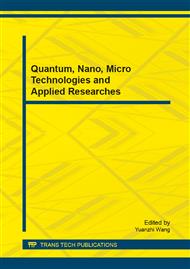p.133
p.137
p.141
p.146
p.153
p.158
p.162
p.171
p.180
Experimental Study on Temperature during Wire Saw Slicing
Abstract:
Heat generated during wire saw slicing can cause silicon temperature raise and make silicon wafer warpage, especially for larger silicon wafers. In order to study the wire saw effect on silicon temperature during slicing process, three kinds of wire saw, mainly semi-fixed abrasive wire saw and traditional wire saw, are applied for slicing silicon ingot. In this paper, the thermocouple is used to measure the temperature of the silicon during wire saw slicing. The experiment results show that the temperature of the silicon increases along with the wire saw working direction and reaches maximum value near the outlet position of silicon. The temperature of the silicon sliced by semi-fixed abrasive wire saw is lower than that sliced by traditional wire saw.
Info:
Periodical:
Pages:
153-157
Citation:
Online since:
December 2013
Authors:
Price:
Сopyright:
© 2014 Trans Tech Publications Ltd. All Rights Reserved
Share:
Citation:


